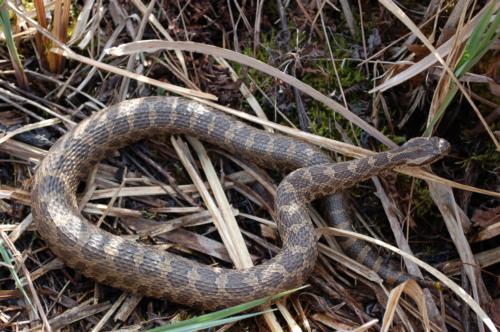
Disease endangering local snakes to be focus of research presentation

A Grand Valley biology professor and multiple students are conducting research in an effort to keep a species of rattlesnake being threatened by snake fungal disease off the U.S. Endangered Species list.
Jennifer Moore, assistant professor of biology, will present her team’s research and a history of the disease in Michigan Thursday, July 23, from 7-8:30 p.m. at Pierce Cedar Creek Institute (701 W. Cloverdale Road, Hastings, MI).
Moore said her team is actively studying eastern massasauga rattlesnakes in Michigan that carry snake fungal disease. This species of rattlesnake is small, venomous and generally found in small populations in wetland habitats. In Michigan, they can typically be found in the Lower Peninsula.
Moore said the eastern massasauga rattlesnake species is threatened or endangered in every state where they reside, except for Michigan, where they are listed as a “species of special concern.” She added that the species is a candidate for federal listing under the U.S. Endangered Species Act and will likely be listed by the end of this year.
“We currently don’t know what impact this disease will have on wild snake populations, but all rattlesnakes that have been brought into captivity for potential treatment have died, so the potential for serious declines exists,” Moore said.
Snake fungal disease was first detected in Michigan massasaugas in 2013. Aside from studying population demography and how habitat management activities may affect the presence of the disease, Moore’s team is also aiming to better understand the ecology of the fungus, Ophidiomyces, which causes snake fungal disease.
Moore explained that Grand Valley biology majors Danielle Bradke, Nate Kudla and Jeff Bartman have been conducting the bulk of this research.
“Letting the students ask the important questions, carry out the work and tell people about what they discovered is great training for their future careers in science,” Moore said. “ They are hard-working, dedicated and enthusiastic about this project, which makes them an absolutely integral part of the work.”
For more information or to register for the presentation, visit the Pierce Cedar Creek Institute website or call (269) 721-4190.
Subscribe
Sign up and receive the latest Grand Valley headlines delivered to your email inbox each morning.








